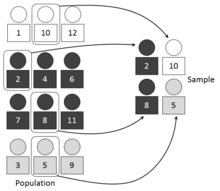This article needs additional citations for verification. (December 2020) |
In statistics, stratified sampling is a method of sampling from a population which can be partitioned into subpopulations.

In statistical surveys, when subpopulations within an overall population vary, it could be advantageous to sample each subpopulation (stratum) independently.
Stratification is the process of dividing members of the population into homogeneous subgroups before sampling. The strata should define a partition of the population. That is, it should be collectively exhaustive and mutually exclusive: every element in the population must be assigned to one and only one stratum. Then sampling is done in each stratum, for example: by simple random sampling. The objective is to improve the precision of the sample by reducing sampling error. It can produce a weighted mean that has less variability than the arithmetic mean of a simple random sample of the population.
In computational statistics, stratified sampling is a method of variance reduction when Monte Carlo methods are used to estimate population statistics from a known population.[1]
- ^ Botev, Z.; Ridder, A. (2017). "Variance Reduction". Wiley StatsRef: Statistics Reference Online: 1–6. doi:10.1002/9781118445112.stat07975. ISBN 9781118445112.